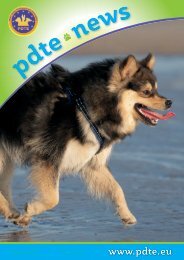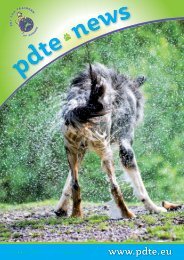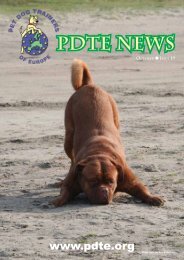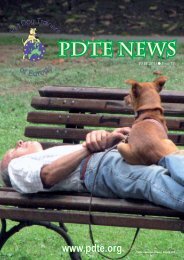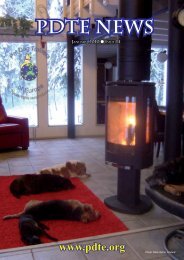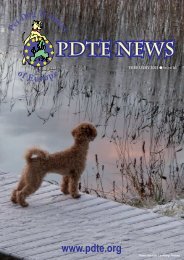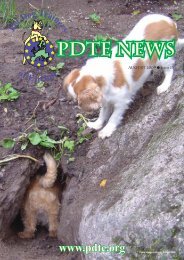PDTE 2013 Winter Newsletter
Create successful ePaper yourself
Turn your PDF publications into a flip-book with our unique Google optimized e-Paper software.
A strong partnership:<br />
Empowerment to an<br />
intimidating environment<br />
UNDINE<br />
NICKERL,<br />
GERMANY<br />
TOMTE<br />
My canine friend Tomte knows cues or<br />
signals, not commands. We don’t do<br />
obedience training like “Sit“ or “Heel“.<br />
Instead, he knows “Wait“ and does<br />
this reliably. He likes to run off-leash<br />
and to immerse himself in his own<br />
world. He doesn’t always have time<br />
for me. Sometimes, other things are<br />
more important to him. But that’s all<br />
right. When I call him, he comes to me<br />
happily and quickly. This reliable recall<br />
means freedom and safety for him.<br />
Tomte has already learned a lot. He<br />
knows how to behave well in our human<br />
world. If he gets into an exciting<br />
or upsetting situation, he is now able<br />
to cope with it, of his own accord. It’s<br />
important to me to give him as much<br />
latitude as he needs to be content. He<br />
is allowed to make his own decisions<br />
and gain his experiences. At the same<br />
time, I am always there whenever he<br />
needs support. This has made Tomte<br />
confident and self-reliant. Our relationship<br />
is characterized by mutual<br />
respect and trust. I like him a lot, and I<br />
think he likes me, too. We are friends.<br />
It has not always been like this. He<br />
came to me unexpectedly, out of the<br />
blue, on Christmas Eve of 2007. Friends<br />
of mine – veterinarians volunteering<br />
for a spay-and-neuter project in<br />
Southern Europe – had found him<br />
lying injured at the side of a highway.<br />
The first time I saw him he was<br />
extremely malnourished and suffering<br />
from an old, untreated luxation of the<br />
hip.<br />
He underwent surgery for his hip<br />
and recovered quickly. In the following<br />
weeks I got to know a dog who<br />
showed timid, insecure or fearful<br />
reactions in almost any given situation.<br />
It was only in interaction with our<br />
dogs that we saw him exuberant and<br />
happy, acting freely. In such situations<br />
he seemed like a perfectly normal,<br />
healthy dog. He became familiar with<br />
us quite soon, too, and his behaviour<br />
towards us was careful, but increasingly<br />
open. Severe problems developed<br />
on our walks. After a phase of absolute<br />
passivity he began to bark and snap<br />
at passers-by, lorries, motorbikes and<br />
other dogs. Outdoors, anything that<br />
moved was too much for him. Our<br />
dog-walking area is much frequented<br />
by dogs, strollers, children, joggers,<br />
cyclists and mountain bikers. In order<br />
to get there, we have to cross a street<br />
with a very high volume of traffic.<br />
Over the following weeks my walks<br />
with him became extremely stressful<br />
and dangerous. More than once he<br />
almost pulled me into traffic because<br />
I had not noticed a truck in time. I had<br />
to see all potential fear triggers before<br />
he did, in order to make the situa-<br />
32









